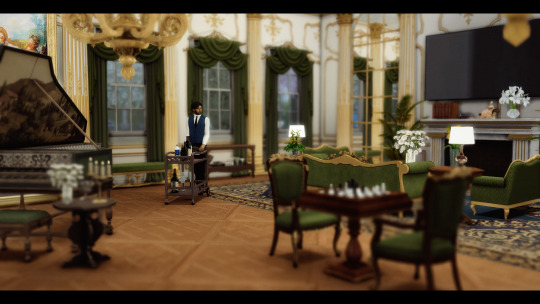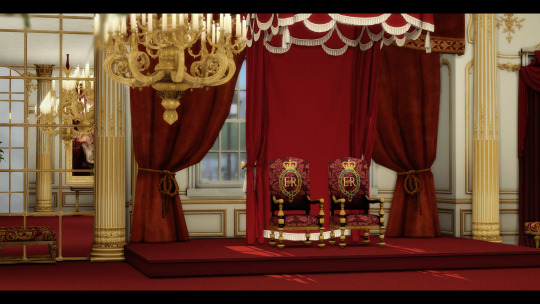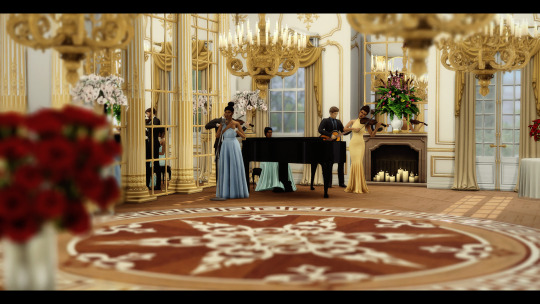#i playtested it and it seems fine i hope it works if u do do gameplay if not ummm
Photo









THEDEVILLIERS — ‘the palace’ build
a collab between @thebrixtons and I! she built the greatest shell ever + landscaped the garden surrounding the main build. 💖 the palace has three fully decorated floors and it includes a throne room, ball room, studies, a library, private bedrooms, etc!
- 64x64 lot
- enable bb.moveobjects before placing!
- very cc heavy [5.57gb]. the only packs (barely) used were: get famous, get together and get to work.
- i recommend this no drift camera mod if you want to use the third floor.
- - i use k-hippie’s terrain replacements and terrain paint.
- most cc is included [more info + photos on dl page!] thank you to all cc creators used in this build 😌💕
@emilyccfinds @itsjessicaccfinds @sssvitlanz
download: patreon (free, no ads)
#ts4 lot#ts4cc#s4cc#sims 4 lot#ts4 build#ts4build#ts4 palace#s4 lot#s4 build#ts4 cc#ts4 simblr#simblr#finally !!!!!!!!!!!!!!!!!!!!!!! after 8000 years of posting wips on me patreon its here lksdfjksdlfs#i playtested it and it seems fine i hope it works if u do do gameplay if not ummm#also theres no kitchen no comment#the garden n office in my latest posts are from here : )#i think i will release emis horse stables once i actually finish placing the 40093092 ivy cc
443 notes
·
View notes
Text
Pathfinder Playtest Review, Part 2
This is part 2 of my review of the Pathfinder Playtest from Paizo. You can see part 1 here where I cover the first three sections of the book (Overview through Classes). In this part of the review, I’ll comment on the next four sections (Skills through Spells). The next review should cover Advancement and Options, and Playing the Game, which will be a big chunk of the review process since this is the “meat” of the game. Lastly, I’ll finish up with Game Mastering through Appendices.
If you’re interested in reading along with me during the review, you can pick up the free PDF of the playtest rulebook at Paizo’s site:
One note that I forgot to drop into my first review is that I’m making notes as I go through a section, then I do my best to accurately expand on those notes “in media res,” so that I’m giving an accurate depiction of my thoughts as they come to me as I read the text. Certainly, there will be some things that pop up later in the book that may change my mind, but I wanted to be clear that this is not a “I’ve read the whole book and am now making comments.”
Skills
A new concept for Pathfinder is the use of skills in untrained and trained manners.
Share1
Tweet1
+11
Reddit1
Email
A new concept for Pathfinder is the use of skills in untrained and trained manners. There are some actions a character can take even without being trained in a skills, but the more potent or advanced uses of a skill are reserved for those with training. This is pretty cool. I like this change in the game. In the playtest book, the list of untrained uses feels a little longer than the trained uses do. Perhaps this will be adjusted in the final product. I really hope to see the trained uses for the skills expanded upon.
While the list is shorter in this edition, I’m not going to go into each skill. I’m just going to comment on some of the larger changes. I do like the shorter list of skills, though. They feel more focused and on target for what a modern roleplaying game should be. Having said that, I think each skill needs more actions (more on this later when we get to feats) to make them worthwhile to the game.
Identifying Items/Effects
I’ve always felt it was too easy in Pathfinder to identify items.
Share1
Tweet1
+11
Reddit1
Email
Something I find interesting is that identifying magic items or magical effects is now a skill check without needing the spells of “detect magic” or “identify.” This takes a full hour per item/effect. I like this change for several reasons. First, I’ve always felt it was too easy in Pathfinder to identify items. In the “old school” versions of D&D, it was exceedingly difficult to identify items. I think this approach strikes a fine balance. Secondly, this skill-based approach aligns more closely with what we read in fantasy literature, which is all about the storytelling. This brings some storytelling back into the game. While I’m on this topic, I also noticed that there are several skills that can be leveraged for identifying magic. These are arcane, nature, occultism, and religion. It’s pretty neat that they applied this use to all of these areas.
Aside: Read Magic
The ability to read magical (or occult or holy) texts is now skill-based. As a matter of fact, the spell “read magic” is no longer in the book. It just takes some time, effort, skill, and a decent die roll to interpret magical writings. Like with identifying magic items/effects, I like this change quite a bit because it more closely aligns our collaborative storytelling efforts with what we read in fantasy novels.
CMB/CMD/Attack Actions
I hadn’t noticed that CMB and CMD weren’t part of the character sheet or character generation process until I got to the athletics skill. Some of the uses of the skill allow for tripping, grappling, shoving, etc. However, instead of the CMB/CMD combination, Paizo has streamlined these actions even more! I’m impressed that they’ve managed to pull this off. Now, it’s a skill check against a saving throw (usually Fortitude or Reflex) to see if the action has the desired effect.
Downtime Skills
This turns downtimes into more fun roleplaying instead of the less fun rollplaying.
Share1
Tweet1
+11
Reddit1
Email
Crafting, lore, and perform can be used between exploring and adventuring to earn some coin for the characters. The subsystem for earning these coins is consistent, easy to implement, and quick to resolve. By moving some of the crunchy bits into a simpler system, there can be more focus on what goes on with the characters during downtime other than doing the necessary math to figure out how much income someone earns. This turns downtimes into more fun roleplaying instead of the less fun rollplaying.
Lore
It appears that the lore skill is now the combination of knowledge and profession skills from the previous edition. I like this simplification because it helps players pick skills in a faster manner, reduces confusion in the game, and allows for a greater breadth of skill choices to be made. I’m not sure how many times I’ve been asked something along the lines of, “What is profession? What do I use it for? How it is different from craft or knowledge?” Dropping these two skills together under a single entity is a boon.
Society
This skill feels misnamed. I like the actions and activities under it. They make sense. However, this is more of a “streetwise” skill than a “society” skill. Paizo should consider renaming the skill to streetwise.
Feats
(Author note: I’m using “feat” here even though I like the word “talent” better because I think that’s what Paizo has turned them into for this version of Pathfinder. I’ll stick with Paizo’s naming convention to avoid confusion.)
Of the skill-based feats, there are some pretty cool ones in here.
Share1
Tweet1
+11
Reddit1
Email
Remember how I said above under the “Skills” header that I wanted more uses for the skills to make them worthwhile? Yeah. I take that back. Now that I’m in the feats section, I see that a vast majority of the feats (all but 20) are there to give skills more oomph. Now I see why characters get so many feats at character creation and as they level up. I was truly concerned that a 1st level character would have a chain of feats that would overpower them out of the gate. It doesn’t appear to be the case.
Again, I’m not going to go into each feat in detail. There just isn’t enough room in a single article to do so. I’ll just say here that there are some really cool feats that allow for both player and GM interactions with the characters’ skills that can drive a story forward (or sideways) in an excellent story-driven manner. It feels to me, as I read through the feats, that Paizo is taking on a bit more “fluff” into their rules and a little less “crunch.” What I mean by this is that Paizo seems to be taking on less of a “tactical simulation of combat” feel that has put some people off and shifting their balance a little toward the story side of things. Don’t get me wrong, Pathfinder still has those crunchy bits for when combat arrives, but that’s not all there is to this game.
Of the 20 “general feats,” only one requires a level higher than first. This gives quite a few options for starting characters, but I’d like to see the list expanded in the final book. While reading through the feats, my gut tells me there is room for growth of options there, but I can’t quite pin down what’s missing. A more thorough analysis than a read-through would probably reveal this to me.
Of the skill-based feats, there are some pretty cool ones in here, and there are quite a few options to customize and make characters special in their own way. No two masters of a single skill will look the same or use that particular skill the same. This intrigues me and piques my interest quite a bit. A friend of mine complained about the number of feats as “too many options,” but I don’t think there’s quite enough here to cause analysis paralysis, to be honest. It’s a good set to work with, and I can see the list being expanded in the final release or in expansion books.
Equipment
Equipment is equipment, right? Well, there are some subtle changes to how equipment is acquired and handled in game that need to be illuminated. Again, I’m not going to go into each bit of armor, each weapon, each piece of gear, etc. here. I’m going to talk about the rules exposed in this section.
Rarity
Items now have a “rarity” attribute. These start with common and range through uncommon to rare and finally land at unique. A color code is used to denote the rarity when an item is listed, which I’m not a big fan of. A single letter (C, U, R, X) inside parentheses after the item name would suffice. There are also folks that are color blind out there, so the red (uncommon) or blue (unique) item listing may be problematic for them. It’s best to stick with black (or dark hued inks) on white (or pale hues) for text, Paizo. I hope someone on the development team sees this and perks up a bit. Also, either I missed uncommon/rare items in the equipment lists, or they’re not present in the playtest book. I couldn’t find anything in the regular equipment other than black text (common items). Having said all this, I do like the potential I see in the rarity of items.
Item Level
When I saw this, I panicked. I thought Paizo was going the way of MMORPGs and stating that characters couldn’t have or use certain items until they were of a certain level. Fortunately, this is not the case. The “item level” listing is a guideline for GMs, so they don’t accidentally hand out something as treasure that might unbalance the game.
Bulk
Instead of weight and strength determining a weight limit for encumbrance or not, Paizo abstracted things away to a degree. Now items have a “bulk” listing, which determines how much stuff a character can carry before slowing down or being forced to drop something. The system looks straightforward and simple enough that I might start using encumbrance again. (I currently “hand wave” encumbrance for my players in Pathfinder, so long as they don’t get crazy with it.) There’s even a page (along with some handy tables) dealing with items made for a creature of different size. It’s pretty easy to figure out the bulk of a small creature trying to use or carry something intended for a large creature.
Item Quality
Items have “levels” like characters skills do. They can be normal, expert, master, or legendary in make. This isn’t even counting the magical weapons. This is a cool expansion on the “masterwork” concept that’s been around since D&D 3.0. The hardness, cost, and bonuses of the item go up as the quality increases. This new feature in the system can be leveraged in “low magic” settings where most sword aren’t be magical, but legendary weapon crafters can produce high quality swords that are +3 without magic. This spawned quite a few setting ideas for me. I really love this shift and addition to the game. Oh, before I forget, there are rules for items of “poor” quality as well. This is an excellent addition for settings like Dark Sun.
Spells
This article is already getting a little long in the tooth, so I’ll try to make this as brief as possible while giving spells the attention they deserve. Like with the other sections, I’m not going to delve into each spell.
Heightened Spells
A caster can choose to prepare a spell at higher spell slots to increase the effects of the spell. Not all spells can be heightened, but many can. The example in the book is that a fireball (3rd level) will do 6d6 damage. If you heighten the spell (by putting in a 4th level slot), it will do 8d6 damage instead. This system provides for greater flexibility in how prepared spellcasters do their thing and plan for the day. It’s subtle, but effective, and I like it. There are also rules for the spontaneous casters to be able to do the same thing, but the rules are subtly different.
Spell Schools and Traits
The typical spell schools we’ve all grown to love and adore are still present in the game. The various spell traits that exist within the Pathfinder playtest book are also outlined and clearly explained. The list of traits is a bit short, though, as I found some spells without explained traits. However, the “good” trait is pretty clear, but it would be best to explain them all for those who are new to Pathfinder or roleplaying.
Rarity of Spells
In the equipment section, I talked about the different rarity of items. A similar system of common, uncommon, and rare exists within the spell lists. Players are restricted from automatically choosing uncommon and rare spells without the GM’s permission. One thing of note here is that Paizo uses a superscript of U or R for uncommon and rare spells instead of the strange color-coding mentioned in the equipment section. I hope that Paizo finds a proper superscript for “Unique” equipment as well and applies the superscript (or some other symbology) to use to alleviate the color blindness issue that some players may have.
Actions in Spellcasting
Each part of casting a spell (material, somatic, and verbal) takes an action.
Share1
Tweet1
+11
Reddit1
Email
As I mentioned in the first part of this review, each PC gets 3 actions per round. I found an interesting quirk here in the spellcasting section. Each part of casting a spell (material, somatic, and verbal) takes an action. This means that a spell with all three components to cast will consume all three actions of the caster during that round. Something with only somatic and verbal will take two of the three actions, and so on. I had stop and ponder the implications of this for a bit. I can see the game balancing effects of this approach. However, I had to flip the very last page of the book (where the spell sheet is at) and look at it. Having a variable number of actions for different spells requires the proper bookkeeping, memorization, or stopping the game to look things up to figure out how many actions a particular spell consumes. The spell sheet does have an “actions” section with three blanks in it for each spell. This will assist in keeping the game running smoothly if players do the right thing and fill out the sheet with all details as they acquire new spells.
Spell Details
While I’m not going to dig through each spell in the book, I wanted to point out that powers gained from various ancestries, classes, feats, backgrounds, etc. that are spell-like in nature are comingled in the alphabetical list of spells. This can easily lead to confusion because the section is clearly labeled “Spells” in the tabs on the right edge of the page. I would recommend that Paizo take the “Spells” label and change it to “Spells and Powers,” so players new to the game can easily track down the specific section of the book they need to find the details about all of the supernatural things their characters can do.
Also, in the spell details section, Paizo falls back to a colored background for the rarity of spells to indicate uncommon and rare. Again, I’m not a fan of this because it requires rote memorization (or a spot in the GM screen) to translate the rarity of a spell from color to meaning. Sorry to harp on this poor decision by Paizo, but it’s really gotten to me. I’ll step away from the soapbox on this topic.
Conclusion, For Now
Coming into reviewing the Pathfinder playtest, I was hesitant to even pick up the book, but I wanted to give the game a fair shake. So far, I’m liking what I’m seeing. Yes, there are limited choices within the book, but it’s also a “slim” book (for a core Paizo book, at least) at only 428 pages. Compare that against the current edition’s core book size of 575 pages, there’s ample room to expand and grow and improve.
So far, I think I would play this game as a replacement for the current Pathfinder. However, as the saying goes, “The proof’s in the pudding.” So far, I’ve been reading about the “ingredients” of the overall recipe. The next few segments of the book will be telling on how good the actual pudding is going to be.
I’ll roll this part of the review to a close, so I can get to how to mix the ingredients together and make the pudding. You’ll be seeing section 3 of the review here in about two weeks if all goes according to plan. See ya then!
Pathfinder Playtest Review, Part 2 published first on https://supergalaxyrom.tumblr.com
0 notes